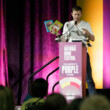If you come to Earth
Description
From two-time Caldecott Winner author-illustrator Sophie Blackall!
If You Come to Earth is a glorious guide to our home planet, and a call for us to take care of both Earth and each other.
This beautiful book is inspired by the thousands of children Sophie Blackall has met during her travels around the world in support of UNICEF and Save the Children.If you come to Earth, there are a few things you need to know . . .We live in all kinds of places.In all kinds of homes.In all kinds of families.Each of us is different. But all of us are amazing.And, together, we share one beautiful planet.?This masterful and moving picture book is a visually comprehensive guide to the earth, imbued with warmth and humor, that celebrates the magic of ordinary days on our beloved home planet.
- An engaging storybook about a single curious and imaginative child
- Simultaneously funny and touching
- Carries a clear message about the need to care for the earth and each other
Perfect for:
- Ideal for children ages 3 to 5 years old
- Resonates year-round as a go-to gift for birthdays, holidays, baby showers, and more
- A great pick for teachers looking for a crowd-pleasing picture book with lessons about the world for little students
- Parents, grandparents, and caregivers
- A new Earth Day book resource for exploring the science and wonder of nature, life, and the universe
- Add it to the shelf with books like Here We Are by Oliver Jeffers, Miss Rumphius by Barbara Cooney, The Travel Book Lonely Planet Kids, and Hello, World! by Jill McDonald
More Details
9798885190381
145213779
9781452146836
Similar Titles From NoveList
Similar Authors From NoveList
Published Reviews
Booklist Review
The cover establishes the concept with a young boy looking up from Earth, drawing on a long roll of paper that spirals into the sky. His message is being received by a spaceship, hovering close to the sun. As he adds narrative to his pictures, he sends an invitation: "Dear Visitor from Outer Space, / If you come to Earth, / here's what you need to know." Hand-lettering furthers the feeling that the boy is writing the words himself. With ink-and-watercolor art that is vivid, delicate, and precise, Blackall composes intricate spreads that express the vast diversity of the planet, ranging from wider scopes--the solar system, land, and sea--to closer up--homes, transportation, families, bodies, food, and animals. The boy describes people communicating with words, sign language, Braille, art, and music. The sense is that if you are on Earth, you belong, though the boy also acknowledges that bad things happen here. Some don't have enough to eat; lose homes to fire, flood, or war; get sick or have accidents. Nonetheless, he thinks visitors would find his world beautiful. As a two-time Caldecott winner, Blackall is deservedly celebrated, and here she pairs her accomplished artwork with a story children will want to read and a message that resonates. This is one to take your time with, savor, and share with others.
Publisher's Weekly Review
Meeting children from around the world gave Caldecott Medalist Blackall (Hello Lighthouse) a vision of a book "that would bring us together," she explains in an author's note. This exquisite catalogue of human experience is the result. A child with an elfin red cap, white skin, and black hair frames the story, addressing a "Visitor from Outer Space." Magnificent spreads journey through the solar system and descend toward the Earth's surface, zeroing in on a quilted landscape. Fragmentary, often droll descriptions of Earth-side existence follow, about bodies and aging, home and travel, eating and drinking ("Some of us have more food than others"), and relationships ("Sometimes we hurt each other. It's better when we help each other"). Wide-eyed human characters of varying shapes, ethnicities, and abilities show kind regard for each other: a librarian offers a tissue to a man overcome, dinner table companions share animated conversation. Even for the accomplished Blackall, the artwork is dazzling. Encyclopedic paintings of the natural world--birds, sea life, an acorn, and more--are rendered in painstaking detail and brilliant colors. It is a book that can be shared with strangers, visitors, friends old and new--a work in which differences build to reveal an inclusive human family on a single, precious planet. Ages 5--8. (Sept.)
School Library Journal Review
PreS-Gr 1--If visitors came to Earth, what would they need to know? A young boy, Quinn, writes a letter to potential visitors in Blackall's stunning new book. Her signature Chinese ink and watercolor illustrations will draw children in for repeat readings to pore over each detail, such as the portraits of people from diverse backgrounds, from a construction worker and a firefighter to Ruth Bader Ginsburg and Librarian of Congress Carla Hayden. Images such as a two-page spread of different types of birds arranged in the shape of a bird invite dialogue from prereaders, expanding their background knowledge about animals, transportation, or kinds of houses. Each page is well researched and inclusive, as Blackall depicts the many different people who live in the world. The inclusivity of various abilities is especially notable, including the American Sign Language alphabet, images of Braille, different types of families, and people using wheelchairs. The author's note tells how she came to know the real Quinn, an Australian boy with dark hair and light skin. VERDICT With its gorgeous and intricate illustrations, this is perfect for sharing one on one, and is recommended for most collections.--Jessica Ko, Los Angeles P.L.
Horn Book Review
Quinn, a small child in a red gnome hat, writes a letter to potential visitors to our planet to explain to them what we're about: our location in the universe, our geography, our natural world, and the varied ways we humans manage housing, clothing, transportation, family life, and getting along. It's a promising (and idealistic) premise, and Blackall deftly captures the approach and tone of a child writer. "Fish can swim but they can't walk. Most animals can walk or swim or gallop or hop, but they can't fly. Some birds can swim and walk and fly, so if I had to choose, I'd be a bird." The true delight of the book, however, lies in its stunning illustrations. Each page features a dynamic, energetic composition, a wealth of precise detail arranged in unexpected ways. For instance, a flock of various birds forms the shape of a single bird if you squint. There are games to play, from finding Quinn in the crowd to recognizing some famous people among the field of folk that Blackall portrays (Ella Fitzgerald, Ruth Bader Ginsburg, and Carla Hayden, to name a few). The robust subtext is diversity in all the usual areas as well as quirkier ones, such as all the different ways humans can arrange our legs to sit comfortably on a picnic blanket. Sweet, funny, moving, timely, and beautiful. Sarah Ellis September/October 2020 p.57(c) Copyright 2020. The Horn Book, Inc., a wholly owned subsidiary of Media Source, Inc. No redistribution permitted.
Kirkus Book Review
To take care of one another and the Earth, we must truly see one another as unique and valued. A young child with light beige skin, wispy brown hair, and a gnomish red cap writes an invitation: "Dear Visitor from Outer Space, / If you come to Earth, / here's what you need to know." What follows is a child's introduction to this complex planet that begins in the child's room, spins out to outer space, then back to Earth and its geography and topography, then to the people who inhabit this planet--where they live, how they live, and what they do. Along the way, outer-space visitors (and readers) learn about families, careers, clothing, transportation, fauna, even the American Sign Language and Braille alphabets. Throughout, diverse people are distinctively, carefully portrayed, emphasizing representation and visibility. In a library scene, the narrator says, "It's better when we help each other"--an urgent response to a portrayal of war on the preceding spread. Two-time Caldecott Medalist Blackall balances eye-catching double-page spreads with white space, even focusing on a single powerful image--for instance, one giant bird formed from dozens of small birds fit together. Ribbons appear throughout the book, as winding blue rivers and spools of illustrated paper covered with the narrator's extraterrestrial drawings. Each rich illustration invites return visits to investigate all the small, and big, details it contains. An author's note explains the global origin of this offering. An introduction to Earth for children big and small who live in this galaxy, or beyond. (Picture book. 4-8) Copyright (c) Kirkus Reviews, used with permission.
Booklist Reviews
*Starred Review* The cover establishes the concept with a young boy looking up from Earth, drawing on a long roll of paper that spirals into the sky. His message is being received by a spaceship, hovering close to the sun. As he adds narrative to his pictures, he sends an invitation: "Dear Visitor from Outer Space, / If you come to Earth, / here's what you need to know." Hand-lettering furthers the feeling that the boy is writing the words himself. With ink-and-watercolor art that is vivid, delicate, and precise, Blackall composes intricate spreads that express the vast diversity of the planet, ranging from wider scopes—the solar system, land, and sea—to closer up—homes, transportation, families, bodies, food, and animals. The boy describes people communicating with words, sign language, Braille, art, and music. The sense is that if you are on Earth, you belong, though the boy also acknowledges that bad things happen here. Some don't have enough to eat; lose homes to fire, flood, or war; get sick or have accidents. Nonetheless, he thinks visitors would find his world beautiful. As a two-time Caldecott winner, Blackall is deservedly celebrated, and here she pairs her accomplished artwork with a story children will want to read and a message that resonates. This is one to take your time with, savor, and share with others. Preschool-Grade 2. Copyright 2020 Booklist Reviews.
Publishers Weekly Reviews
Meeting children from around the world gave Caldecott Medalist Blackall (Hello Lighthouse) a vision of a book "that would bring us together," she explains in an author's note. This exquisite catalogue of human experience is the result. A child with an elfin red cap, white skin, and black hair frames the story, addressing a "Visitor from Outer Space." Magnificent spreads journey through the solar system and descend toward the Earth's surface, zeroing in on a quilted landscape. Fragmentary, often droll descriptions of Earth-side existence follow, about bodies and aging, home and travel, eating and drinking ("Some of us have more food than others"), and relationships ("Sometimes we hurt each other. It's better when we help each other"). Wide-eyed human characters of varying shapes, ethnicities, and abilities show kind regard for each other: a librarian offers a tissue to a man overcome, dinner table companions share animated conversation. Even for the accomplished Blackall, the artwork is dazzling. Encyclopedic paintings of the natural world—birds, sea life, an acorn, and more—are rendered in painstaking detail and brilliant colors. It is a book that can be shared with strangers, visitors, friends old and new—a work in which differences build to reveal an inclusive human family on a single, precious planet. Ages 5–8. (Sept.)
Copyright 2020 Publishers Weekly.School Library Journal Reviews
PreS-Gr 1—If visitors came to Earth, what would they need to know? A young boy, Quinn, writes a letter to potential visitors in Blackall's stunning new book. Her signature Chinese ink and watercolor illustrations will draw children in for repeat readings to pore over each detail, such as the portraits of people from diverse backgrounds, from a construction worker and a firefighter to Ruth Bader Ginsburg and Librarian of Congress Carla Hayden. Images such as a two-page spread of different types of birds arranged in the shape of a bird invite dialogue from prereaders, expanding their background knowledge about animals, transportation, or kinds of houses. Each page is well researched and inclusive, as Blackall depicts the many different people who live in the world. The inclusivity of various abilities is especially notable, including the American Sign Language alphabet, images of Braille, different types of families, and people using wheelchairs. The author's note tells how she came to know the real Quinn, an Australian boy with dark hair and light skin. VERDICT With its gorgeous and intricate illustrations, this is perfect for sharing one on one, and is recommended for most collections.—Jessica Ko, Los Angeles P.L.
Copyright 2020 School Library Journal.
































